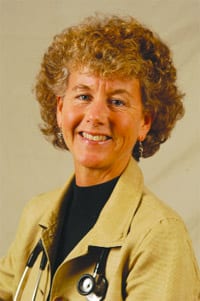CDH Infection Rate Drops Further with UV Room Disinfection
NORTHAMPTON — In America’s hospitals, approximately one in 20 patients will contract a hospital-acquired infection (HAI). At Cooley Dickinson Hospital last year, only one in 129 patients got an HAI. Now, those better odds of avoiding an infection at CDH have improved even further, as the hospital has documented a groundbreaking 82{06cf2b9696b159f874511d23dbc893eb1ac83014175ed30550cfff22781411e5} drop in one type of infection, Clostridium difficile (C. diff), a nasty germ that can cause diarrhea, sepsis, and even death.
“This decrease translates to many more people leaving the hospital safer and with better outcomes,” said Dr. Joanne Levin, CDH’s medical director of Infection Prevention.
The 82{06cf2b9696b159f874511d23dbc893eb1ac83014175ed30550cfff22781411e5} drop in incidence of C. diff occurred following adoption in January of room cleaning with portable UV light, an added step among many CDH already takes to eliminate infections, reported Levin. Cooley Dickinson Hospital was the first hospital in the Northeast to use the Xenex PX-UV Disinfection System.
“The work of CDH staff to keep patients far safer than other hospitals is terrific, but two C. diff infections is still two too many,” said President and CEO Craig Melin as he applauded the efforts of hospital staff, particularly Environmental Services and nursing team members, to accommodate the additional step of UV disinfection.
Levin explained that the “dramatic decrease in C. diff transmission occurred during the time when most of the patient rooms and bathrooms were disinfected with the UV light.”
Melin added that “Cooley Dickinson’s extra efforts mean the chances of getting an infection in this hospital are significantly less than 1{06cf2b9696b159f874511d23dbc893eb1ac83014175ed30550cfff22781411e5}, compared to a 5{06cf2b9696b159f874511d23dbc893eb1ac83014175ed30550cfff22781411e5} risk in general in the natio.”
Cooley Dickinson had a strong infection prevention program in place before adding the UV disinfection, and the program — which includes best-practice room cleaning and proper hand hygiene — was already lowering infection rates, Levin said. But a bug like C. diff requires a stronger weapon than the tools previously in place.
Specific rates of C. diff infections are not available, but the Centers for Disease Control and Prevention (CDC) tracked a nearly twofold increase in C. diff infections from 1996 to 2003. Two statewide studies in Oregon and Massachusetts found C. diff infections increasing at an even faster pace. The C. diff. germ can be found in the community and can be transmitted when a patient is in any care facility, including a hospital or a nursing home.
What makes C. diff especially virulent is that the organism can make spores, which are like seeds with a hard shell. Even strong hospital cleaning products can’t penetrate the shell, Levin said. Subsequently, C. diff can live in an environment for months. In one study, C. diff disease was found on 49{06cf2b9696b159f874511d23dbc893eb1ac83014175ed30550cfff22781411e5} of surfaces in hospital rooms housing a patient with the infection and on 29{06cf2b9696b159f874511d23dbc893eb1ac83014175ed30550cfff22781411e5} of surfaces in rooms with a patient who carries the germ but has no symptoms, according to a March 2011 report in Infection Control & Hospital Epidemiology.
C. diff is a bacterium that causes inflammation of the colon. According to the CDC, the elderly and people who have other illnesses or conditions requiring prolonged use of antibiotics are at greater risk of acquiring this disease.
UV light has long been used as a hospital disinfectant, starting in the 1950s when it was used to clean the air in TB wards. Levin said the light fell out of favor over the years due to maintenance and cost concerns. Brian Cruver, CEO of Xenex, said that other room-disinfection technologies have been in use for several years but have been unable to produce successful patient outcome data. Cooley Dickinson Hospital’s results, he said, “offer proof to hospitals of what our unique pulsed-xenon technology can do.”
According to Xenex, the UV disinfection system has consistently shown to be more than 20 times more effective against C. diff and other ‘superbugs’ than standard cleaning practices alone. The Xenex system quickly kills microorganisms on surfaces and in the air without contact or additional chemicals. The UV light penetrates the cell walls of the germ, fusing their DNA together, leading to instant damage, the inability to reproduce or mutate, and killing the organism.
“We are striving to eliminate the transmission of infections through a combination of best cleaning practices, hand hygiene, surveillance, and technology, such as the hospital-wide use of UV room disinfection,” said Levin. “We are more aggressively implementing these practices, and our effort is paying off for our patients.”


